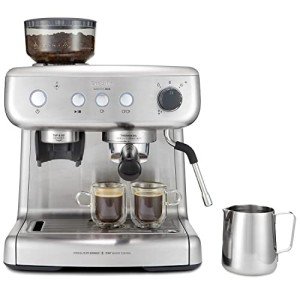The Most Significant Issue With Heat Exchange Espresso Machines, And How You Can Fix It
Heat Exchange Espresso Machines: A Comprehensive Guide
Espresso machines have actually developed substantially over the years, dealing with the requirements of home baristas and coffee experts alike. Among these machines, heat exchange espresso machines have actually acquired popularity due to their ability to deliver consistent performance and exceptional brew quality. In this article, we will check out the functions, advantages, and essential functions of heat exchange espresso machines, supplying a comprehensive understanding for both prospective buyers and coffee lovers.
Comprehending Heat Exchange Technology
Heat exchange espresso machines run on an unique concept that permits simultaneous water heating for developing and steaming. They are geared up with a single boiler that uses a heat exchanger system. This function is considerable as it enables users to brew espresso while steaming milk simultaneously, promoting performance in the coffee-making process.
How Does a Heat Exchange Espresso Machine Work?
The process starts with the machine's water inlet filling the boiler. As the water heats up, it turns to steam. The ingenious heat exchanger uses hot steam to heat additional water in a separate passage designed particularly for the brew group. Commercial Espresso Machines means that water can reach the ideal developing temperature without awaiting the boiler to change. The essential steps include:
- Water Fill: Water is drawn into the boiler.
- Heating Process: The boiler warms up as water is transformed into steam.
- Heat Exchange: Steam warms water in the heat exchanger tube.
- Brewing: Water from the heat exchanger is pressed through coffee premises, extracting the flavors needed for an abundant espresso.
This procedure permits fast temperature adjustments and improved coffee extraction.
Advantages of Heat Exchange Espresso Machines
Heat exchange espresso machines use numerous benefits, particularly for those wanting to optimize their coffee experience. Here are some key advantages:
- Simultaneous Brewing and Steaming: Users can brew espresso while steaming milk, making it ideal for busy cafes and home baristas who value performance.
- Temperature Stability: The boiler's steam pressure assists preserve a stable temperature level, which is important for consistent espresso extraction.
- Flexibility: The style enables quick switching in between brewing and steaming, making it much easier to develop different coffee drinks, from lattes to cappuccinos.
- Easy to use: Models frequently come with accessible controls, making it possible for both novices and skilled baristas to produce quality beverages.
- Professional Quality: Heat exchange machines are typically used in commercial settings, offering users with high-quality developing efficiency at home.
Secret Features to Look for in Heat Exchange Espresso Machines
When thinking about the purchase of a heat exchange espresso machine, there are several features that one ought to take into account:
- Build Quality: Look for machines made of long lasting products, such as stainless steel or brass, ensuring durability.
- Boiler Size: A bigger boiler will hold more water and sustain greater output over time.
- PID Temperature Control: This feature helps preserve consistent brew temperatures, which can enhance the coffee-making process.
- Group Head Design: Machines with a saturated or semi-saturated group head offer much better temperature stability.
- Alleviate of Use: User-friendly user interfaces and instinctive controls improve the total experience for baristas at all ability levels.
- Steam Wand Quality: A good steam wand with proper insulation and flexibility permits much better texturing of milk.
- Water Reservoir Size: Depending on your requirements, consider how often you desire to fill up the water tank.
Contrast of Popular Heat Exchange Espresso Machines
To better comprehend the options available in the market, below is a contrast table of some popular heat exchange espresso machines:
Machine Model
Boiler Size
PID Control
Cost Range
User Ratings
Profitec Pro 700
2.0 L
Yes
₤ 2,000-₤ 2,500
9.5/ 10
Rocket Espresso R58
1.8 L
Yes
₤ 2,400-₤ 2,800
9.4/ 10
Elekta Bianca
1.8 L
Yes
₤ 2,500-₤ 3,000
9.6/ 10
La Spaziale S1 Vivaldi II
1.5 L
Yes
₤ 1,800-₤ 2,200
9.2/ 10
Bezzera Magica
1.2 L
No
₤ 1,600-₤ 1,800
9.0/ 10
Frequently Asked Questions About Heat Exchange Espresso Machines
What is the primary distinction between a heat exchange and a dual boiler espresso machine?
While both types can brew espresso and steam milk at the same time, dual boiler machines have separate boilers for brewing and steaming. On the other hand, heat exchange machines use a single boiler and a heat exchanger to attain the very same function.
Are heat exchange machines appropriate for novices?
Yes! Numerous heat exchange machines are designed with easy to use functions, making them accessible for novices. With correct guidance and practice, users can rapidly produce quality espresso.
What sort of maintenance do heat exchange espresso machines require?
Regular maintenance consists of descaling, cleaning up the boiler, examining seals and gaskets, and keeping the group head clean. Routine maintenance guarantees durability and constant performance.
Can I use a heat exchange machine for different types of coffee drinks?
Absolutely! Heat exchange machines allow users to produce a range of coffee beverages, consisting of espresso, lattes, coffees, and more.
Heat exchange espresso machines represent a mix of innovation and tradition, providing coffee lovers with the tools required for crafting the ideal cup. Their ability to all at once brew and steam, integrated with accurate temperature level control, makes them an engaging choice for both home baristas and specialists. With the best understanding on functions and upkeep, users can open a world of elegant coffee experiences, guaranteeing that each sip is as delightful as the last.
